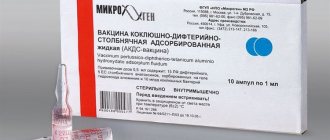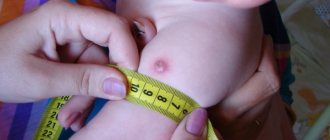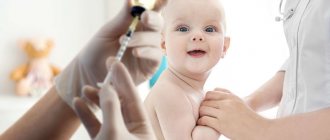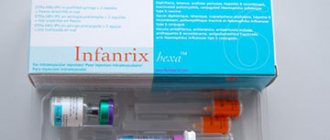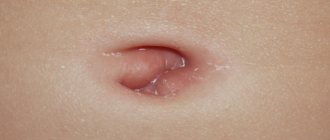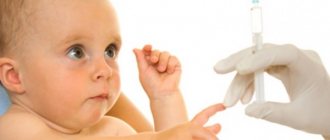BCG is one of the first vaccinations given to a newborn baby. A vaccine is introduced into the child's body to prevent the occurrence of pulmonary tuberculosis and its other clinical forms. Russian children are required to be vaccinated with BCG, since tuberculosis is a common infectious disease, the activity of which is due to the unfavorable epidemiological situation in the country. Parents must understand the importance of preventive procedures. The appearance of the area where the injection solution was injected may cause fear for some time. And, in order not to panic, you should imagine how a wound from BCG heals, what the injection site should normally look like at different stages of healing.
BCG vaccination: how it heals
After the administration of the BCG vaccine, immunity is formed in the child’s body against bacteria that provoke pulmonary and extremely dangerous extrapulmonary tuberculosis. An intradermal injection is made in the shoulder. The development of the reaction to the vaccine is slow.
The healing process includes the formation of an abscess, covering it with a crust, and finally the formation of a scar. All stages take more than one month.
What does the injection site look like immediately after receiving the vaccine?
The medical specialist administering the solution must be attentive and focused: the drug must be squeezed out of the needle not subcutaneously, but into the skin. If he did the job correctly, a small papule appears on the shoulder, in the center of which the puncture point is visible. It is similar to the reaction to the Mantoux test, has a diameter of 5-10 mm, and is noticeably lighter than the surrounding skin.
The papule lasts for 15-20 minutes, the skin around it may turn slightly red. This is fine. The formation of a papule is evidence that the vaccination was done correctly. If blood accumulated at the injection site, the needle was inserted deeply, and the solution ended up in the subcutaneous layer.
How does healing proceed during the first days after vaccination?
In the first 2-3 days after the procedure, the skin around the injection point swells and turns red. This skin reaction lasts 3-4 days, then disappears on its own. Parents should take into account that normally the reaction should only involve the area of the injection papule.
The healing process is normal: in the first weeks and thereafter
If the BCG injection is done correctly, contraindications are taken into account, wound healing should proceed without complications. This process is lengthy and includes the following stages.
- Papule formation. It is usually white, but can be red or even burgundy if the subcutaneous layer is affected. At the stage of the presence of a nodular formation, an increase in body temperature is possible; this is not evidence of pathology.
- A month or a month and a half after the injection, the area where the drug was administered turns red.
- A bubble is formed filled with liquid purulent contents.
- The purulent mass breaks out of the bladder, but new pus forms in the wound. A purulent ulcer is a normal stage of healing; it is strictly forbidden to scratch it, press it, or lubricate it with antiseptic medications.
- The purulent process ends with the formation of a crust on the surface of the wound. It cannot be torn off or treated with anything.
- The ripened crust falls off on its own.
What the BCG vaccination should look like in the end
In place of the fallen off crust, a scar remains, indicating a successful procedure. The diameter of the scar area ranges from 2 to 10 mm. The duration of the BCG healing stages and the size of the scar determine the level of acquired immunity. The longer the skin tissue took to heal, the larger the scar area, the stronger the resulting immunity against tuberculosis.
In the absence of a scar, we can confidently say that immunity to tuberculosis has not appeared. That is, the administration of the vaccine turned out to be ineffective. But parents should not panic in this situation. If the Mantoux test shows a negative result, repeated BCG vaccination is necessary. If the result is positive, the child undergoes the next procedure at 7 years of age.
There is no reaction to the first vaccination in 5% of infants. Moreover, approximately 2% of the world's inhabitants have a genetically formed immunity to the infection that causes tuberculosis. These people are not at risk of catching an infectious disease, and they have no trace after the BCG vaccination.
Precautionary measures
To reduce the risk of possible complications, parents need to adhere to certain rules of behavior, both before and after BCG vaccination.
- It is recommended to carry out an allergy test before the injection to make sure that the baby’s body reacts normally to this drug.
- After vaccination, it is not allowed to wet or lubricate the injection site with any ointments or antiseptics.
- You cannot make an iodine grid or squeeze the pus out of the vesicle yourself.
- It is necessary to ensure that the baby does not scratch the injection site.
- Do not try to tear off the crust yourself.
- It is important not to introduce new foods into the diet of a child or nursing woman two weeks before and after. In the case of an allergic reaction, this may make it difficult to determine the cause that provoked such manifestations.
BCG: how long does it take to heal?
The main symptoms are noted a month or a month and a half after the procedure. How long it takes for BCG to heal in infants cannot be said with certainty: the duration of the reaction depends on the characteristics of the body and many other factors. In most cases, the formation of an abscess lasts almost two months, and the formation of a crust and scar takes about a month. How BCG heals at 7 years old also depends on the immune system. Normally, the Mantoux test should look like an injection point.
During the period of formation of immunity to tuberculosis, the following processes occur in the child’s body, which are not pathological:
- redness of the skin at the injection point;
- a small abscess at the stage of scarring of skin tissue;
- purulent accumulations in the wound, not accompanied by tissue swelling and severe redness;
- itching, signaling that the vaccine is working and the skin is healing;
- swelling of the skin, confirming the presence of an immune response to the administered drug;
- a slight increase in temperature, lasting no more than 3 days, provoked by the appearance of antibodies to the vaccine in the blood.
If the temperature after the injection lasts more than 3 days, the child should be urgently taken to the pediatrician.
What is
BCG is an abbreviation for Bacillus Calmette - Guérin. This vaccination is aimed at protecting against tuberculosis; it is a strain of weakened tuberculosis bacillus isolated from a cow. It does not pose a danger to people; it is specially raised in an artificial environment.
This vaccine is aimed at:
- Preventive measures against tuberculosis infection.
- Allows you to reduce the percentage of sick people among children.
- It completely protects not from the risk of infection, but from preventing a latent infection from developing into an open disease.
- Prevents the development of complications in case of illness, such as tuberculous meningitis, dangerous forms of infection of the lungs, infection of the skeletal system.
- In cases of infection, it occurs in a mild form.
- In case of infection, it prevents the risk of death.
It is recommended to get the BCG vaccination literally in the first days after birth, while still in the maternity hospital, if the baby has no contraindications. In addition, two more BCG vaccinations may subsequently be carried out, in which case they will already be talking about revaccination.
The need for this vaccination is due to the fact that children under five years of age, when infected with Koch's bacillus (tuberculosis), have a fairly high mortality rate, especially for newborns and infants.
After vaccination, after one and a half to two months, long-term immunity is formed in the baby’s body, which protects the little one from infection.
Possible deviations and complications in healing
Complications after administration of the BCG vaccine are rare. Typically, patients with innate weak immunity experience negative consequences. In children with immunodeficiency, in 90% of cases local negative reactions are observed: inflammation of the lymph nodes, severe growth of a purulent focus. But in general, side effects occur in only one vaccinated child out of 1000.
A side effect may be osteomyelitis - purulent necrosis of bone tissue. But such a serious complication is a consequence of the poor quality of the injection solution. According to medical statistics, in almost all cases of complications the medical specialist is to blame for either giving the injection incorrectly or using a low-quality drug.
The most common complications include:
- cold abscess - a limited accumulation of pus, resulting from the subcutaneous insertion of a needle, developing a month after the procedure, requiring surgical intervention;
- extensive ulcerative formation exceeding 1 cm in diameter, which occurs when the child’s body is sensitive to the vaccine, is treated with topical medications;
- inflammation of the lymph nodes, which develops when introduced bacteria penetrate through the blood into the lymph nodes (if the node reaches more than 1 cm, it is removed surgically);
- keloid - a reddened and swollen scar resulting from a skin reaction to the vaccine;
- a generalized infectious lesion of the body that develops in the presence of disturbances in the functioning of the immune system;
- Osteitis is a bone tuberculosis that appears about a year after the procedure due to immune disorders.
How to care for a papule after vaccination in a baby
- The papule should heal naturally, so it is forbidden to lubricate it with brilliant green, iodine, as well as all kinds of disinfectant solutions and ointments.
- Do not open the bottle of liquid yourself. If this happens by accident, no special treatment is required, as a characteristic crust should form.
- If a crust is accidentally removed with the subsequent formation of a wound, the baby must refrain from water procedures that day and also avoid contact with water.
- The vaccination site should not be rubbed or soaped, as this may disrupt the formation of immune defense.
Take a free online TB test
Navigation (job numbers only)
0 out of 17 tasks completed
- 1
- 2
- 3
- 4
- 5
- 6
- 7
- 8
- 9
- 10
- 11
- 12
- 13
- 14
- 15
- 16
- 17
Information
This test will help you determine whether you have tuberculosis.
You have already taken the test before. You can't start it again.
You must log in or register in order to begin the test.
You must complete the following tests to start this one:
results
Categories
- No category 0%
Congratulations! The likelihood that you will develop tuberculosis is close to zero.
But don’t forget to also take care of your body and undergo regular medical examinations and you won’t be afraid of any disease! We also recommend that you read the article on identifying tuberculosis in the early stages.
There is reason to think.
It is impossible to say with certainty that you have tuberculosis, but there is such a possibility; if it is not Koch bacilli, then there is clearly something wrong with your health. We recommend that you undergo a medical examination immediately. We also recommend that you read the article on identifying tuberculosis in the early stages.
Contact a specialist urgently!
The likelihood that you are affected by Koch bacilli is very high, but it is not possible to make a diagnosis remotely. You should immediately contact a qualified specialist and undergo a medical examination! We also strongly recommend that you read the article on identifying tuberculosis in the early stages.
- 1
- 2
- 3
- 4
- 5
- 6
- 7
- 8
- 9
- 10
- 11
- 12
- 13
- 14
- 15
- 16
- 17
- With answer
- With a viewing mark
Does your lifestyle involve heavy physical activity?
- Yes, daily
- Sometimes
- Seasonal (eg vegetable garden)
- No
How often do you take a tuberculosis test (eg Mantoux)?
- I don’t even remember when was the last time
- Every year, without fail
- Once every couple of years
Do you carefully observe personal hygiene (shower, hands before eating and after walking, etc.)?
- Yes, I wash my hands all the time
- No, I don't follow this at all
- I try, but sometimes I forget
Do you take care of your immunity?
- Yes
- No
- Only when sick
- I find it difficult to answer
Have any of your relatives or family members had tuberculosis?
- Yes, parents
- Yes, close relatives
- No
- I can not say for sure
Do you live or work in an unfavorable environment (gas, smoke, chemical emissions from enterprises)?
- Yes, I live permanently
- No
- Yes, I work in such conditions
- Previously lived or worked
How often are you in damp, dusty or moldy environments?
- Constantly
- I'm not there
- Previously was
- Rarely, but it happens
How old are you?
- Under 18
- From 18 to 25
- From 25 to 40
- More than 40
- Woman
- Man
Have you recently felt very tired for no particular reason?
- Very often
- No more often than usual
- I don't remember this
Have you been feeling physically or mentally unwell lately?
- Yes, pronounced
- No more than usual
- No, that didn't happen
Have you noticed a weak appetite lately?
- Yes, there is such a thing, although everything was fine before
- I don't eat much in general
- No, my appetite is fine
Have you recently noticed a sharp decline in your healthy, plentiful diet?
- Yes, I’ve lost a lot lately, although my nutrition is fine
- There is a little, but I wouldn’t say it’s very critical
- I’ve lost a lot of weight lately, but this is the result of proper nutrition!
- No, I didn’t notice this
Have you recently felt an increase in body temperature for a long time?
- Yes, for no apparent reason
- No, that didn't happen
Are you having trouble sleeping lately?
- Yes, this has never happened before
- I have trouble sleeping in general.
- No, I sleep like a baby
Have you noticed increased sweating lately?
- Yes, and very pronounced
- If only a little
- No, that didn't happen
Have you noticed yourself looking unhealthy lately?
- Yes, he's noticeably paler
- No, that didn't happen
Features of vaccination of infants at 3 months
The BCG vaccine is a bacillus that is injected into a child’s body in order to prevent infection with tuberculosis or reduce the development of this disease. Most often, such a vaccination helps make fatal forms of the disease milder, so that children can safely cope with them with the help of certain medications.
The BCG vaccine is initially given in infancy - approximately in the third month of a child's life. To do this, a subcutaneous injection of the drug is made in the shoulder or thigh. The remedy lasts from 5 to 7 years, after which experts recommend revaccination with BCG.
Photo 1. The process of administering the BCG vaccine to a small child in the shoulder, while his hand is carefully held.
The BCG vaccine is a mixture of mycobacteria that were first synthesized by Calmette and Guerin at the beginning of the last century. Scientists have managed to create a culture that has been helping to fight tuberculosis for more than 100 years, with almost no changes.
Bacillus Calmette-Guerin is based on several different forms of the bacteria Mycobacteria bovis. Today, such drugs are manufactured in several countries around the world. Mostly Danish, French, Japanese and British strains of microorganisms are used.
Reference. Most often, BCG vaccination is carried out in the first week of a child’s life. But this does not always happen, because the baby may have certain contraindications to this. In such cases, BCG vaccination is carried out in the third month of life.
When the procedure is canceled or rescheduled
For any vaccination of a child, there are a number of contraindications, which mainly require postponing the procedure for a certain period. This also applies to BCG vaccination. It cannot be carried out:
- if the child is premature, when his body weight does not exceed 2.5 kilograms;
- if the child has any intrauterine infections;
- if there is a history of a diagnosis of hemolytic disease;
- in case of the presence of various purulent-septic diseases on the body;
- in the presence of severe neurological symptoms in case of damage to the central nervous system;
- in the presence of significant lesions of the skin;
- in the presence of various oncological diseases;
- in the presence of primary signs of immunodeficiency;
- when taking immunosuppressive drugs;
- if one or more members of the child’s family have tuberculosis;
- during radiation therapy for the treatment of cancer;
- in the presence of human immunodeficiency virus in the mother.
After the child is two months old, there is a slightly different list of indications for postponing the BCG vaccination procedure. It consists of the following factors:
- the presence of an acute illness in a child;
- allergic reaction to any external substance;
- immunodeficiency state;
- positive or ambiguous reaction of the Mantoux test;
- the presence of malignant tumors of the body or cancer of the blood;
- taking immunosuppressive drugs;
- presence of tuberculosis;
- excessively active adverse reaction to the first BCG vaccination;
- contact with a person with tuberculosis in the recent past.
Important! If the above pathologies and factors are present, the child’s vaccination is postponed until they disappear. In certain cases, it is simply canceled forever due to the impossibility of carrying it out
Contraindications to vaccination for newborns
BCG is not done in the maternity hospital and during the life of the child if he has the following contraindications:
- brain injuries during labor;
- severe genetic pathologies;
- children whose mothers have HIV;
- the child has relatives with pulmonary tuberculosis;
- the presence in relatives of complications from the causative agent of the disease, which led to deterioration of health.
Temporary contraindications when vaccination is prohibited for the baby include:
- birth weight less than 2.5 kilograms;
- serious skin diseases;
- detection of severe erythroblastosis in a newborn;
- intrauterine infection of the fetus.
If the baby was born with a body weight of 1.5-2 kilograms, the amount of the administered substance is reduced, but he is still vaccinated. This injection is called BCG-m. If it is not done in the maternity hospital, then when the child reaches 2 months, he donates blood and urine, and then the baby is given Mantoux. If the result is negative, it is permissible to administer BCG.
Where is the injection given? For infants, the vaccine is injected into the shoulder.
Consequences of wrong behavior
In most cases, BCG vaccination is tolerated without any negative consequences. But in rare cases, complications occur. They are associated either with a violation of the vaccination technique or with the incorrect behavior of parents after BCG. Highlight:
- Abscesses are “cold” due to the introduction of a vaccine and septic when a bacterial infection is attached, the latter occurs when ointment dressings or compresses are applied to the injection site.
- Necrosis of the skin and subcutaneous tissue is often associated with the addition of a secondary infection, a violation of the integrity of the skin against the background of pathology of the immune system.
- Regional lymphadenitis occurs when bacilli are introduced into adjacent lymph nodes and the immune system is weakened.
- Keloid scars are complications after attempts to squeeze out the formed bubble or open the infiltrate.
- Generalized tuberculosis infection is observed quite rarely, but it can be provoked by attempts at mechanical impact on the site of BCG vaccination if there are existing problems with the immune system.
Nonspecific complications after BCG include:
- hyperthermic reaction;
- skin pyoderma;
- erysipelas;
- acute diseases: ARVI, bronchitis, urinary tract infections.
Such consequences arise when the rules of hygiene and skin care are not followed in the period after BCG vaccination, attending mass events, or having extensive contact with sick children and adults.
If complications arise, observation by a pediatrician and consultation with a phthisiatrician are required; in some cases, surgical intervention is required under the guise of special anti-tuberculosis chemotherapy.
Instructions for use
Each package of the drug (for 20 doses) contains:
- 5 ampoules of dry vaccine (1 mg);
- 5 ampoules of solvent (0.2 ml each).
To obtain a dose of 0.05 mg (this is the volume of one injection), immediately before grafting, 2 ml of NaCl solution is injected into the ampoule with the dry preparation. The vaccine dissolves completely within 1 minute. At the same time, it should be shaken. For one injection, 0.2 ml of vaccine is drawn into a 2 ml syringe (this corresponds to 2 doses) and then half of the solution is poured out. The required volume remains in the syringe - 0.1 ml. This dosage is for one healthy child.
Premature babies are vaccinated with BCG M (light version). In this case, the single dose is 0.025 ml. Adult vaccinators are vaccinated at the rate of 0.05 mg of the drug in a volume of 0.1 ml.
BCG cannot be given in combination with other vaccinations. And since this vaccine has a delayed reaction, all subsequent vaccinations are allowed only after a month.
